Volatilität, Wachstum und Finanzkrisen
Diese Forschungsgruppe analysiert die Entstehung von Instabilitäten im Finanzsystem und die realökonomischen Konsequenzen von Finanzkrisen. Dabei werden kausale Reaktionen gesamtwirtschaftlicher Größen auf makroökonomische Schocks identifiziert. Frühwarnmodelle beschreiben das zyklische Auftreten von Vulnerabilitäten im Finanzsystem.
IWH-Datenprojekt: Financial Stability Indicators in Europe
Forschungscluster
Finanzresilienz und RegulierungIhr Kontakt

- Abteilung Makroökonomik
PROJEKTE
01.2022 ‐ 12.2023
Sovereign Risk Shocks
Deutsche Bundesbank
05.2017 ‐ 09.2019
Frühwarnmodelle für systemische Bankenkrisen: Der Effekt von Modell- und Schätzunsicherheit
Deutsche Forschungsgemeinschaft (DFG)
01.2018 ‐ 12.2018
International Monetary Policy Transmission
Deutsche Bundesbank
Referierte Publikationen

A Comparison of Monthly Global Indicators for Forecasting Growth
in: International Journal of Forecasting, Nr. 3, 2021
Abstract
This paper evaluates the predictive content of a set of alternative monthly indicators of global economic activity for nowcasting and forecasting quarterly world real GDP growth using mixed-frequency models. It shows that a recently proposed indicator that covers multiple dimensions of the global economy consistently produces substantial improvements in forecasting accuracy, while other monthly measures have more mixed success. Specifically, the best-performing model yields impressive gains with MSPE reductions of up to 34% at short horizons and up to 13% at long horizons relative to an autoregressive benchmark. The global economic conditions indicator also contains valuable information for assessing the current and future state of the economy for a set of individual countries and groups of countries. This indicator is used to track the evolution of the nowcasts for the U.S., the OECD area, and the world economy during the COVID-19 pandemic and the main factors that drive the nowcasts are quantified.
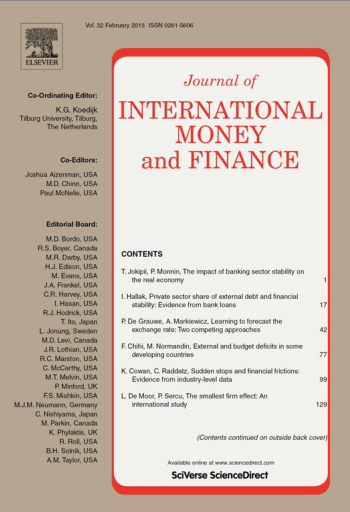
Fiscal Policy and Fiscal Fragility: Empirical Evidence from the OECD
in: Journal of International Money and Finance, July 2021
Abstract
In this paper, we use local projections to investigate the impact of consolidation shocks on GDP growth, conditional on the fragility of government finances. Based on a database of fiscal plans in OECD countries, we show that spending shocks are less detrimental than tax-based consolidation. In times of fiscal fragility, our results indicate strongly that governments should consolidate through surprise policy changes rather than announcements of consolidation at a later horizon.
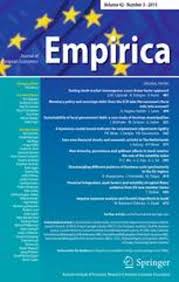
The Appropriateness of the Macroeconomic Imbalance Procedure for Central and Eastern European Countries
in: Empirica, Nr. 1, 2021
Abstract
The European Commission’s Scoreboard of Macroeconomic Imbalances is a rare case of a publicly released early warning system. It was published first time in 2012 by the European Commission as a reaction to public debt crises in Europe. So far, the Macroeconomic Imbalance Procedure takes a one-size-fits-all approach with regard to the identification of thresholds. The experience of Central and Eastern European Countries during the global financial crisis and in the resulting public debt crises has been largely different from that of other European countries. This paper looks at the appropriateness of scoreboard of the Macroeconomic Imbalances Procedure of the European Commission for this group of catching-up countries. It is shown that while some of the indicators of the scoreboard are helpful to predict crises in the region, thresholds are in most cases set too narrow since it largely disregarded the specifics of catching-up economies, in particular higher and more volatile growth rates of various macroeconomic variables.

Optimizing Policymakers’ Loss Functions in Crisis Prediction: Before, Within or After?
in: Macroeconomic Dynamics, Nr. 1, 2021
Abstract
Recurring financial instabilities have led policymakers to rely on early-warning models to signal financial vulnerabilities. These models rely on ex-post optimization of signaling thresholds on crisis probabilities accounting for preferences between forecast errors, but come with the crucial drawback of unstable thresholds in recursive estimations. We propose two alternatives for threshold setting with similar or better out-of-sample performance: (i) including preferences in the estimation itself and (ii) setting thresholds ex-ante according to preferences only. Given probabilistic model output, it is intuitive that a decision rule is independent of the data or model specification, as thresholds on probabilities represent a willingness to issue a false alarm vis-à-vis missing a crisis. We provide real-world and simulation evidence that this simplification results in stable thresholds, while keeping or improving on out-of-sample performance. Our solution is not restricted to binary-choice models, but directly transferable to the signaling approach and all probabilistic early-warning models.

Drawing Conclusions from Structural Vector Autoregressions Identified on the Basis of Sign Restrictions
in: Journal of International Money and Finance, December 2020
Abstract
This paper discusses the problems associated with using information about the signs of certain magnitudes as a basis for drawing structural conclusions in vector autoregressions. We also review available tools to solve these problems. For illustration we use Dahlhaus and Vasishtha’s (2019) study of the effects of a U.S. monetary contraction on capital flows to emerging markets. We explain why sign restrictions alone are not enough to allow us to answer the question and suggest alternative approaches that could be used.
Arbeitspapiere
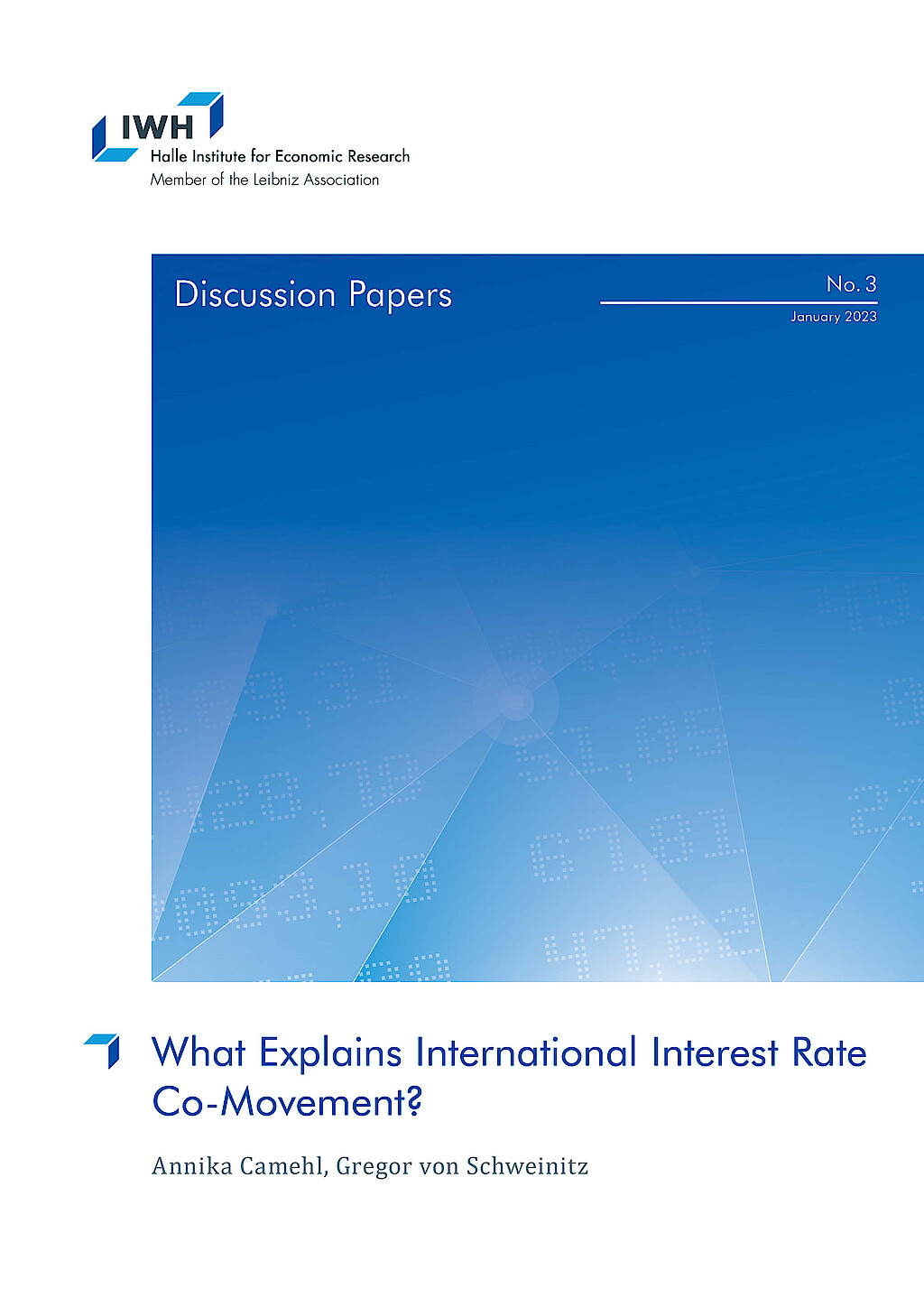
What Explains International Interest Rate Co-Movement?
in: IWH Discussion Papers, Nr. 3, 2023
Abstract
We show that global supply and demand shocks are important drivers of interest rate co-movement across seven advanced economies. Beyond that, local structural shocks transmit internationally via aggregate demand channels, and central banks react predominantly to domestic macroeconomic developments: unexpected monetary policy tightening decreases most foreign interest rates, while expansionary local supply and demand shocks increase them. To disentangle determinants of international interest rate co-movement, we use a Bayesian structural panel vector autoregressive model accounting for latent global supply and demand shocks. We identify country-specific structural shocks via informative prior distributions based on a standard theoretical multi-country open economy model.

The Impact of Active Aggregate Demand on Utilisation-adjusted TFP
in: IWH Discussion Papers, Nr. 9, 2022
Abstract
Non-clearing goods markets are an important driver of capacity utilisation and total factor productivity (TFP). The trade-off between goods prices and household search effort is central to goods market matching and therefore drives TFP over the business cycle. In this paper, I develop a New-Keynesian DSGE model with capital utilisation, worker effort, and expand it with<i> goods market search-and-matching (SaM)</i> to model non-clearing goods markets. I conduct a horse-race between the different capacity utilisation channels using Bayesian estimation and capacity utilisation survey data. Models that include goods market SaM improve the data fit, while the capital utilisation and worker effort channels are rendered less important compared to the literature. It follows that TFP fluctuations increase for demand and goods market mismatch shocks, while they decrease for technology shocks. This pattern increases as goods market frictions increase and as prices become stickier. The paper shows the importance of non-clearing goods markets in explaining the difference between technology and TFP over the business cycle.
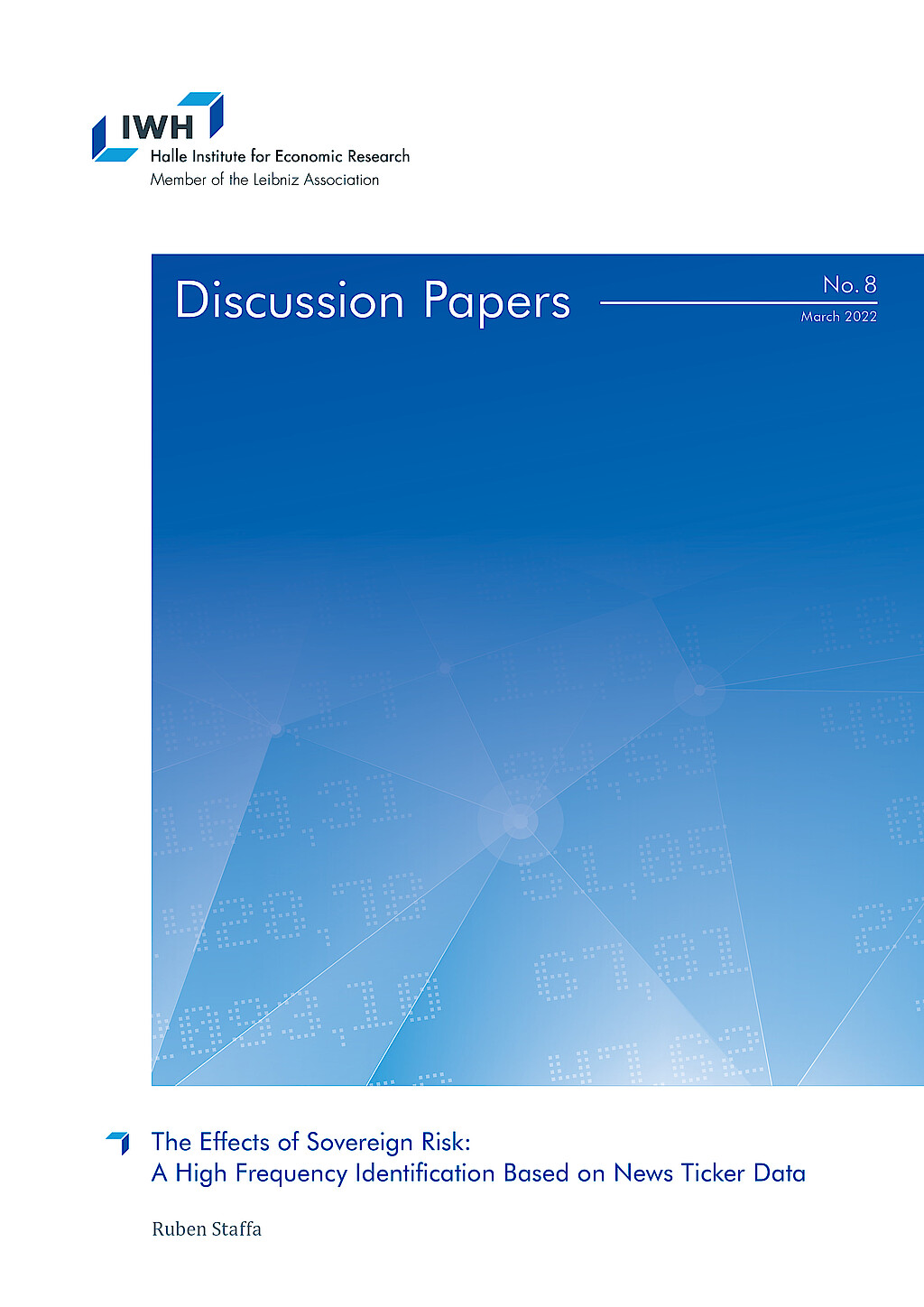
The Effects of Sovereign Risk: A High Frequency Identification Based on News Ticker Data
in: IWH Discussion Papers, Nr. 8, 2022
Abstract
This paper uses novel news ticker data to evaluate the effect of sovereign risk on economic and financial outcomes. The use of intraday news enables me to derive policy events and respective timestamps that potentially alter investors’ beliefs about a sovereign’s willingness to service its debt and thereby sovereign risk. Following the high frequency identification literature, in the tradition of Kuttner (2001) and Guerkaynak et al. (2005), associated variation in sovereign risk is then obtained by capturing bond price movements within narrowly defined time windows around the event time. I conduct the outlined identification for Italy since its large bond market and its frequent coverage in the news render it a suitable candidate country. Using the identified shocks in an instrumental variable local projection setting yields a strong instrument and robust results in line with theoretical predictions. I document a dampening effect of sovereign risk on output. Also, borrowing costs for the private sector increase and inflation rises in response to higher sovereign risk.
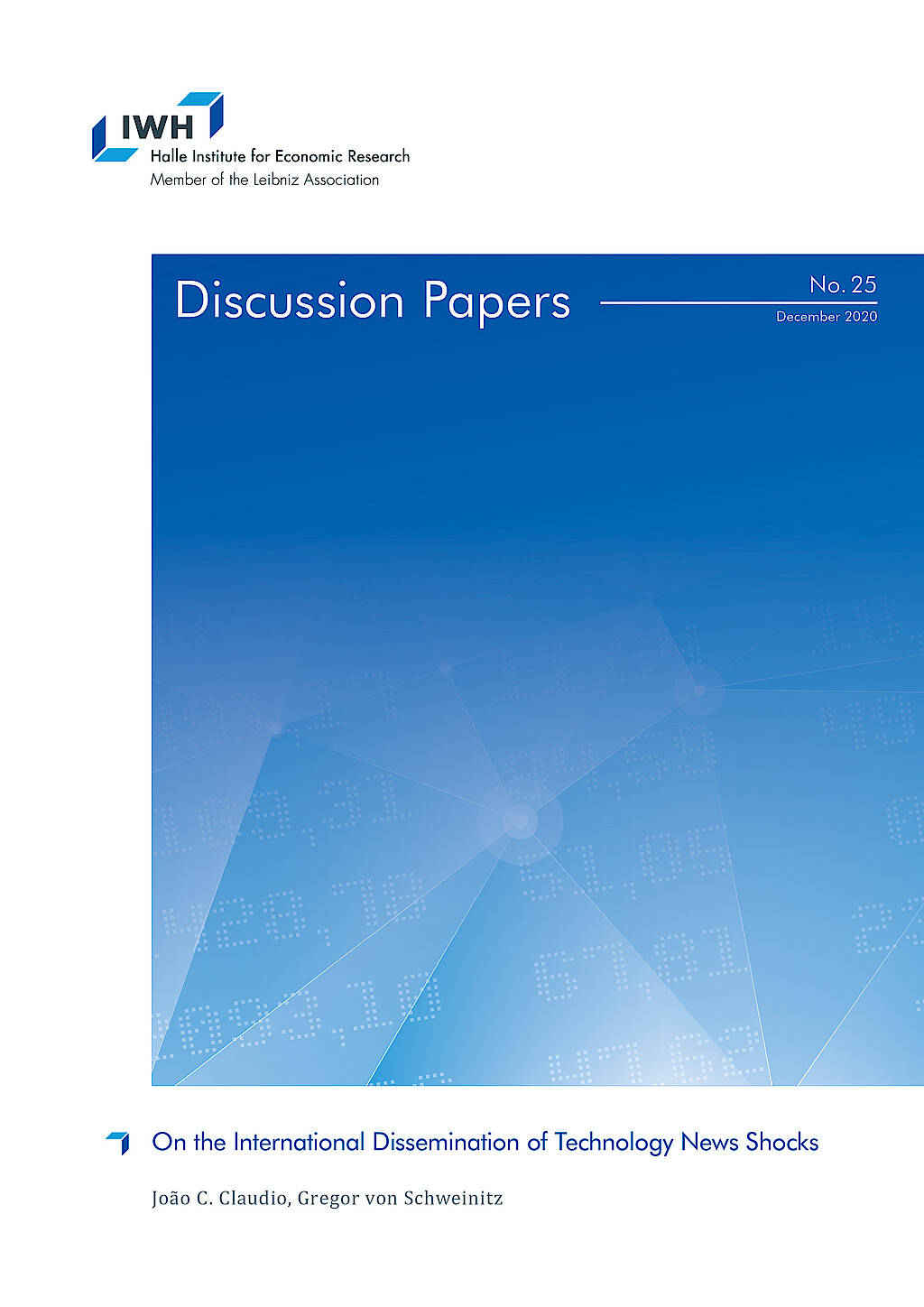
On the International Dissemination of Technology News Shocks
in: IWH Discussion Papers, Nr. 25, 2020
Abstract
This paper investigates the propagation of technology news shocks within and across industrialised economies. We construct quarterly utilisation-adjusted total factor productivity (TFP) for thirteen OECD countries. Based on country-specific structural vector autoregressions (VARs), we document that (i) the identified technology news shocks induce a quite homogeneous response pattern of key macroeconomic variables in each country; and (ii) the identified technology news shock processes display a significant degree of correlation across several countries. Contrary to conventional wisdom, we find that the US are only one of many different sources of technological innovations diffusing across advanced economies. Technology news propagate through the endogenous reaction of monetary policy and via trade-related variables. That is, our results imply that financial markets and trade are key channels for the dissemination of technology.
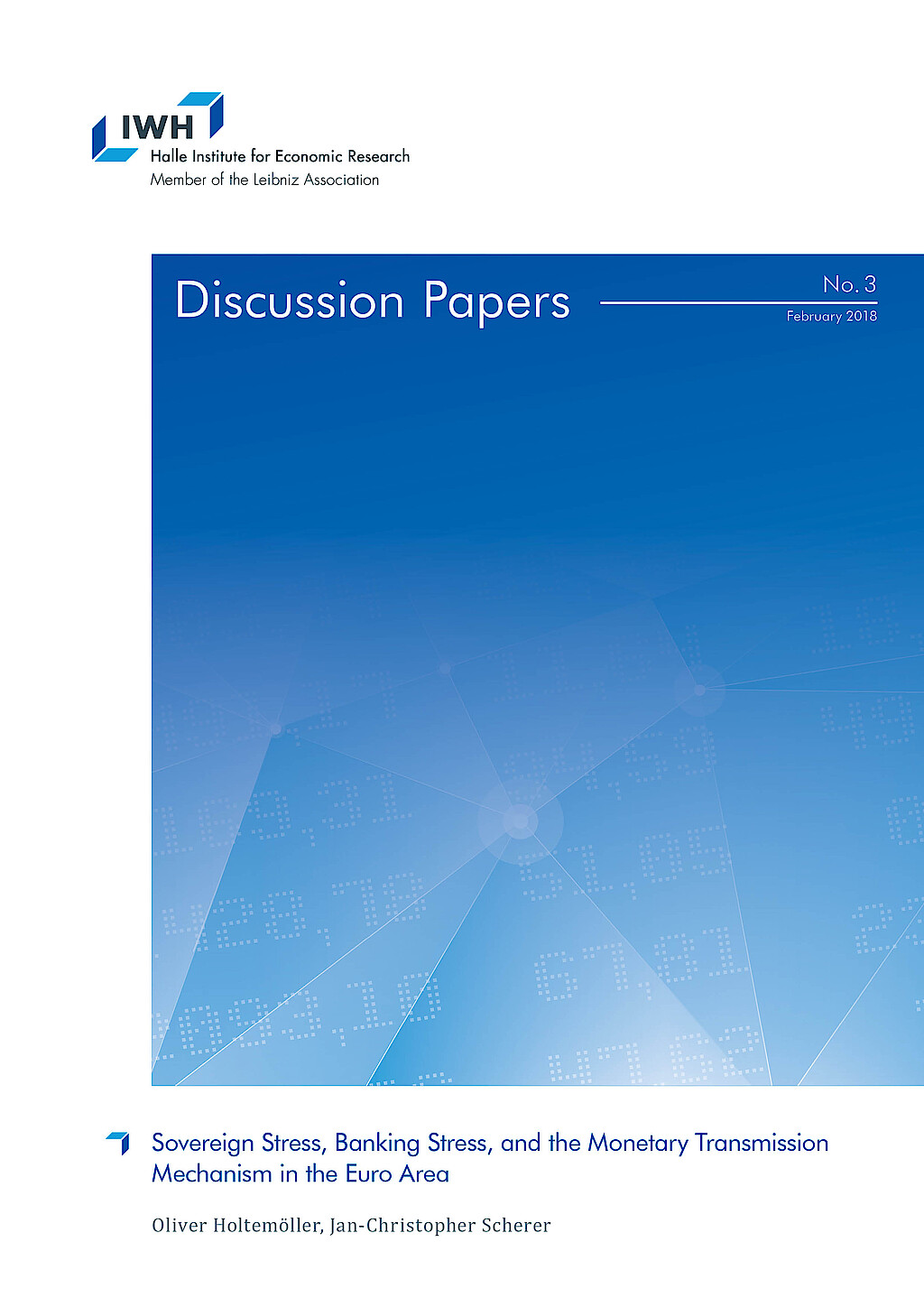
Sovereign Stress, Banking Stress, and the Monetary Transmission Mechanism in the Euro Area
in: IWH Discussion Papers, Nr. 3, 2018
Abstract
In this paper, we investigate to what extent sovereign stress and banking stress have contributed to the increase in the level and in the heterogeneity of nonfinancial firms’ refinancing costs in the Euro area during the European debt crisis and how they did affect the monetary transmission mechanism. We identify the increasing effect of government bond yield spreads (sovereign stress) and the share of non-performing loans (banking stress) on firms’ financing costs using an instrumental-variable approach. Moreover, we estimate both sources of stress to have significantly impaired the monetary transmission mechanism during the European debt crisis.














